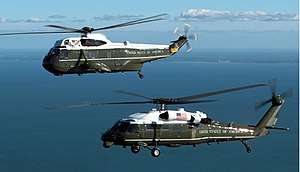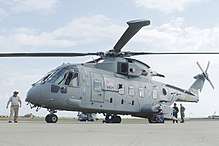VXX
VXX, officially the Presidential Helicopter Replacement Program, is a procurement program to replace aging Marine One helicopters that transport the President of the United States. The current VH-3 helicopters have aging airframes, having entered service with United States Marine Corps Marine Helicopter Squadron One (HMX-1) in 1963. The VH-3D replaced the VH-3A by 1976.[8] The smaller VH-60N was ordered beginning in 1989. On 7 May 2014, it was announced that the Sikorsky VH-92 had won the VXX competition.[9]
| Presidential Helicopter Replacement Program (VXX) | |
|---|---|
 | |
| A Sikorsky VH-3D Sea King and VH-60N | |
| Project for | presidential transport helicopter |
| Requirement | VXX Mission Needs Statement (September 16, 1999)[1] |
| Issued by | United States Navy [2] |
| Service | United States Marine Corps |
| Value | $US 11.2 billion prior to cancellation[3] |
| Date initiated | December 18, 2003 (RFP)[4] |
| Proposals | Lockheed Martin US-101 Sikorsky VH-92[5] |
| Prototypes | Lockheed Martin VH-71 Kestrel Sikorsky VH-92 |
| Date concluded | April 6, 2009[6] |
| Outcome | Round 1: Lockheed Martin VH-71 Kestrel selected for production, but result protested, VH-71 canceled[7] Round 2: Sikorsky VH-92 |

.jpg)
History
The September 11 attacks on the U.S. led to widespread agreement that the Marine One helicopter fleet needed significant upgrades to its communication, transportation, and security systems. But these could not be made due to the weight already added to the aircraft.[10] In 2002, it was proposed to replace the current helicopters. The U.S. Department of Defense issued a request for proposals (RFP) for the VXX helicopter on 18 December 2003 for the supply of 23 helicopters to replace the eleven VH-3Ds and eight VH-60Ns of USMC HMX-1 squadron. In November 2002, the White House asked the Secretary of Defense to accelerate the development of the new aircraft, and DOD said it would have a new aircraft ready by the end of 2008.[10] To do so, DOD asked bidders to begin development and production at the same time.[11]
AgustaWestland and Sikorsky responded to the RFP. Sikorsky proposed the VH-92, a variant of the H-92 Superhawk. On January 28, 2005 the Department of Defense announced that it had selected the US101 for the VXX program. The US101 team was awarded a US$1.7 billion contract for the VXX system development and demonstration (SDD) phase.[12] The Lockheed Martin and AgustaWestland AW101-based US101 bid was given the military designation VH-71 Kestrel in mid-2005.[13]
The replacement cost of the fleet was estimated at $6.1 billion when the VH-71 contracts were signed in 2005. However, by March 2008 the cost of the new 28 helicopter fleet was projected to total US$11.2 billion, or roughly US$400 million per helicopter.[3][14] Political controversy began in February 2009 amid calls for fiscal restraint, and, as a result, President Barack Obama announced that he had instructed Defense Secretary Robert Gates to review the helicopter situation and on 6 April 2009, Gates announced the ending of VH-71 funding, after nine aircraft had already been built at a cost of about US$600 million each.[6]
In February 2010, the U.S. Navy issued a request for information (RFI) to the aviation industry. Responses would be used to restart the VXX contest.[7] In April 2010, Sikorsky and Lockheed Martin announced they would team in offering the VH-92.[15][16] In June, Boeing announced it was considering a licensed version of the AgustaWestland AW101, on which the VH-71 was based, to be built in the United States. Boeing was also considering the Bell-Boeing V-22 Osprey and Boeing CH-47 Chinook for the presidential VXX program.[17][18][19] Whichever platform were picked would be expected to be delivered between 2017 and 2023.[20]
On November 23, 2012, Naval Air Systems Command released a draft request for proposals for a new VXX program.[21] The new requirements lowered the number of people the helicopter had to carry, shortened its range, and simplified its communications. By mid-2013, Boeing, Bell Helicopter and AgustaWestland declined to take part in the project. Only Sikorsky seemed likely to bid on the VXX contract.[22]
On 7 May 2014, the Navy announced that the Sikorsky VH-92 had won the VXX competition, ahead of other potential competitors who decided not to submit a proposal.[9] Subsequent to the VXX competition affairs, in November 2015, Lockheed Martin acquired Sikorsky Aircraft Corporation.
References
- Balderson, William; Thomas Laux; and Martin Post "FY 2006 Marine Corps Major Rotorcraft Programs" Archived July 23, 2011, at the Wayback Machine, statement before the Tactical Air and Land Forces Subcommittee of the House Armed Services Committee, April 7, 2005, p.5.
- Naval Air Systems Command "VXX Program System Development & Demonstration (SDD) Phase", August 26, 2003.
- Cost Nearly Doubles For Marine One Fleet. Washington Post
- Cortes, Lorenzo. "Navy Issues Formal RFP For Presidential Transport Replacement". Defense Daily, December 22, 2003.
- Cortes, Lorenzo. "Navy Likely To Delay VXX Decision Until Next Year". Defense Daily, November 17, 2004.
- NBC News
- Trimble, Stephen. "New VXX competition reveals changes for US presidential helicopter". Flight International, February 18, 2010.
- "VH-3D Sea King helicopter". US Navy, February 20, 2009.
- Majumdar, Dave (May 7, 2014). "Sikorsky Wins $1.24 Billion Contract for Presidential Helo". United States Naval Institute. Retrieved May 7, 2014.
- GAO-11-380R, "Defense Acquisitions: Application of Lessons Learned and Best Practices in the Presidential Helicopter Program", p. 2. Government Accountability Office. Washington, D.C.: U.S. Government Printing Office, 25 March 2011. Accessed 9 September 2013.
- Aitoro, Jill R. "Failed Helicopter Program, Revisited." Washington Business Journal, 28 March 2011. Accessed 9 September 2013.
- "Lockheed Martin to Build New Presidential Helicopter". U.S. Department of Defense January 28, 2005
- "US101 (VH-71A) All Weather Medium Lift Military Helicopter, USA / Europe". Airforce-technology.com. Retrieved June 28, 2010.
- "Executive Branch Strikes VH-71 Deal". Aerospace Daily and Defense Report, March 17, 2008.
- "Sikorsky and Lockheed Martin Announce Teaming Agreement to Compete for the VXX Presidential Helicopter Program" Archived May 1, 2010, at the Wayback Machine. Lockheed Martin
- Cavas, Christopher P. "Former Competitors Join Forces for Helo Program" Archived July 29, 2012, at Archive.today. Defense News, April 19, 2010.
- Fein, Geoff. "Bell-Boeing V-22 Latest Entry For Navy's Presidential Helo RFI". Defense Daily, April 21, 2010. subscription article.
- Reed, John (May 5, 2010). "Boeing to make new multiyear Osprey offer". Marine Corps Times. Archived from the original on March 22, 2012. Retrieved May 6, 2010.
- "Boeing says AW101 one of its three options for VXX". Flight International. June 6, 2010. Retrieved June 10, 2010.
- Sanborn, James K. (May 11, 2011). "New helos, Osprey heading for HMX-1". Marine Corps Times. Archived from the original on July 23, 2011. Retrieved May 13, 2011.
- "New-U-S-Presidential-Helicopter-Program-Kicks-Off". Cavas, Christopher P., Defense News, 23 November 2012.
- Drew, Christopher. "Few Suitors to Build a New Marine One". The New York Times, 29 July 2013.
- Collins, Gail (May 14, 2009). "Trouble on Air Obama". NY Times.
External links
| Wikimedia Commons has media related to Marine One. |